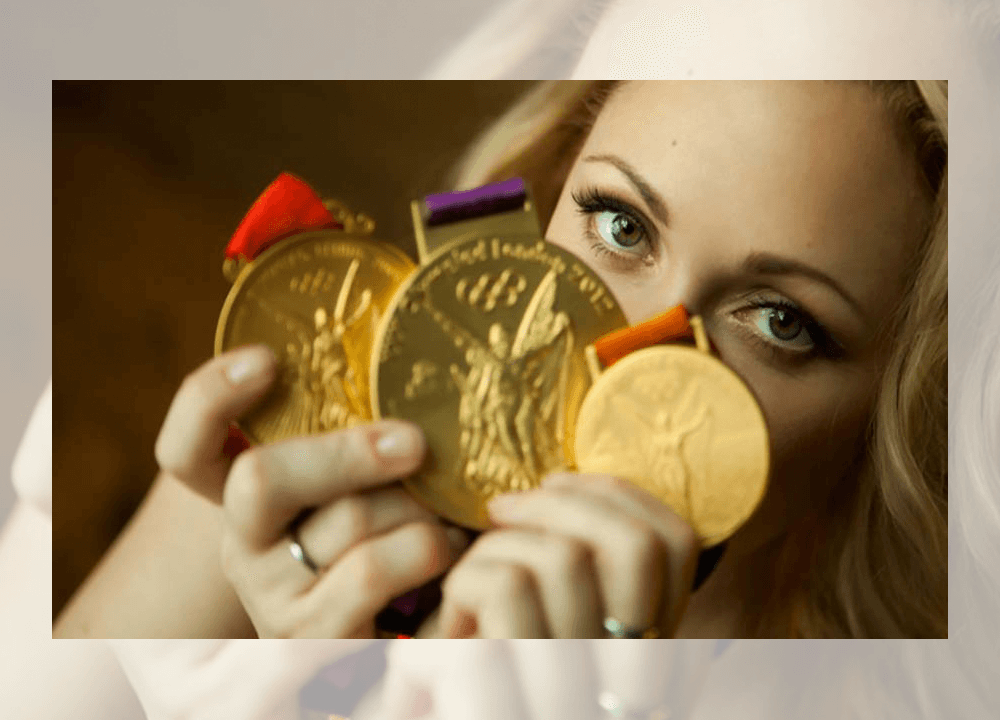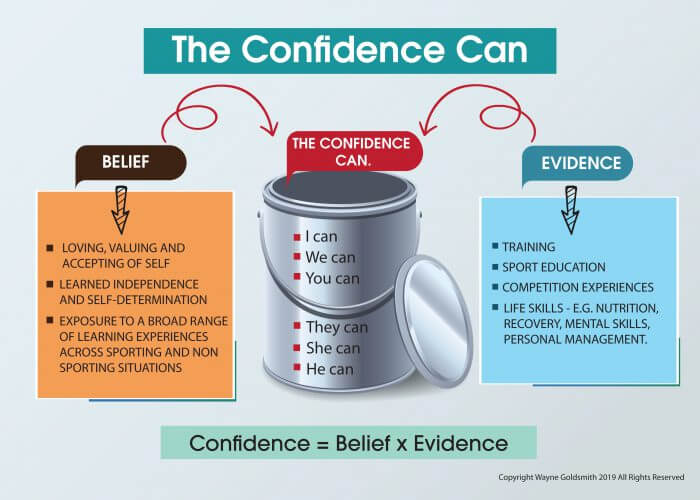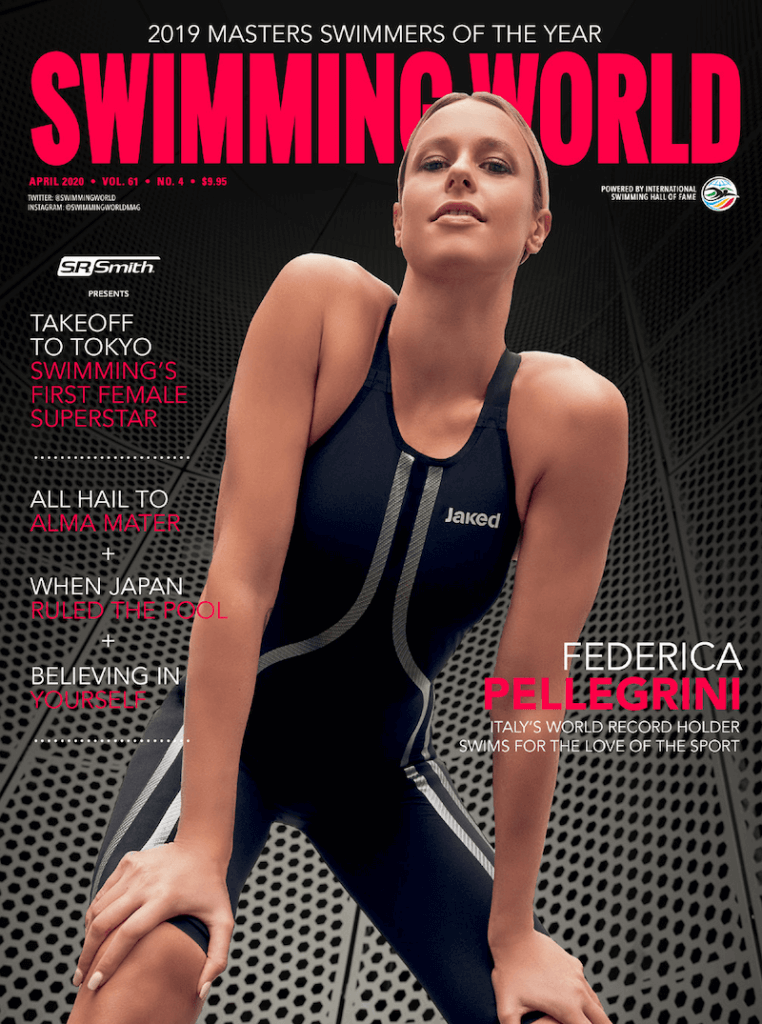Believing in Yourself – Read GoldMinds in Swimming World Magazine April Issue

Wayne Goldsmith says, ‘Believing in Yourself’ shows confidence and is a critically important athletic quality. However, it is not solely the responsibility of the coach to help swimmers to develop the quality of confidence. It is a team effort in which coaches, athletes and parents work together to help build and grow the athlete’s confidence to perform when and where it really matters. Read more about Wayne Goldsmith and his insight on the mental aspect of the sport by downloading the latest edition of Swimming World Magazine form the Swimming World Vault.

“CONFIDENCE comes from KNOWING…and…KNOWING comes from DOING. The more children KNOW they can DO themselves, the more CONFIDENT they become.” – Wayne Goldsmith
Goldsmith, like in the above photo, essentially says the key to believing in yourself is to gain confidence. The equation for confidence is belief multiplied by evidence. Examples of belief are experiences like love, value and acceptance. Examples of evidence are training, sport education and competitive experiences.
Goldsmith has worked with swimmers, coaches, swimming clubs, swimming parents, sports scientists and swimming organizations all over the world for more than 25 years. He has contributed to Swimming World Magazine for nearly two decades. He is one of the world’s leading experts in elite-level swimming and high-performance sport.
THREE-PRONGED APPROACH TO BELIEVING IN YOURSELF
Goldsmith has a multi-layered answer to the commonly asked question “what can I do to help my child develop confidence?”
- To the coaches: “our job is to provide training and competition experiences that give the swimmer the “evidence” that they CAN do—what they need to do—when, where and how they need to do it.”
- To the athletes: “success is a choice. More accurately—it is your choice!”
- To the parents: “stop doing all the little things you do for them … In actual fact, the more you do for them, the less likely it is they will achieve the level of success they and you would like to see them achieve.”
SUMMARY
- Confidence is a vitally important quality that can be learned, grown and mastered by every swimmer.
- Confidence comes from the investment in two things:
- Self-Belief—WHO THE PERSON IS
- Evidence—WHAT THEY DO
- Confidence is a quality that can be inspired by coaches, grown by swimmers and nurtured by parents. If coaches, swimmers and parents work together in the development of confidence, swimmers can achieve remarkable things in the pool and out of it—for the rest of their lives.
Read more about Wayne Goldsmith and his insight on the mental aspect of the sport by downloading the latest edition of Swimming World Magazine form the Swimming World Vault.
Be sure to check out Goldsmith’s websites at www.wgaquatics.com and www.wgcoaching.com.
Get Swimming World Magazine and Swimming World Biweekly FREE When You
Become A Member of the International Swimming Hall of Fame
Want More? Subscribe With This Special 2-Year Offer!
New! 1-Year Digital Only Subscription for just $39.95 Order Now!
Swimming World Magazine April 2020 Issue
FEATURES
014 2019 TOP 12 WORLD MASTERS SWIMMERS OF THE YEAR
by Dan D’Addona, David Rieder and Taylor Brien
022 FOR LOVE OF THE SPORT
by Andy Ross
There is no denying that Federica Pellegrini is the greatest 200 freestyler in history. What makes her illustrious career so special is her approach to swimming—she’s simply doing what she loves.
024 TAKEOFF TO TOKYO: SWIMMING’S FIRST FEMALE SUPERSTAR
by John Lohn
When the Olympic Games return to Tokyo this summer, one of the highlights will be a swimming schedule that is identical for men and women, the 1500 freestyle added for the ladies and the 800 freestyle added to the program for the gentlemen. But the first four editions of swimming at the Modern Olympics did not feature equality, with women not involved until 1912—at which point Fanny Durack made a major splash.
026 ISHOF: WHEN JAPAN RULED THE POOL
by Bruce Wigo
Japan’s men dominated world swimming in the 1930s, a period known as the Golden Age of Japanese Swimming.
030 THE OLYMPIC EFFECT
by Michael Randazzo
The upcoming Tokyo Olympics has shuffled the deck for the 2020 NCAA women’s water polo season.
032 MENTAL PREP: BEFORE THE BEEP WITH CLAIRE DONAHUE
by Shoshanna Rutemiller
COACHING
008 LESSONS WITH THE LEGENDS: GLEN HUMMER
by Michael J. Stott
012 SWIMMING TECHNIQUE CONCEPTS: THE VALUE OF HAND FORCE ANALYSIS: PART I—BUTTERFLY
by Rod Havriluk
While information provided by underwater video alone can be useful, it doesn’t provide a quantitative measure of specific movements. A force analysis gives swimmers and coaches accurate and precise information so they can be absolutely certain of the impact of specific technique elements on performance.
034 ALL HAIL TO ALMA MATER!
by Michael J. Stott
Alumni support positively affects college swimming and diving teams across the country.
036 SPECIAL SETS: TRANSITION TRAINING
by Michael J. Stott
Frank Busch shares how he trained his NCAA national champion University of Arizona athletes in 2008 between NCAAs to the U.S. Olympic Trials.
042 Q&A WITH COACH MIKE LEONARD
by Michael J. Stott
043 HOW THEY TRAIN LUKE PAXTON AND OWEN TAYLOR
by Michael J. Stott
TRAINING
011 DRYSIDE TRAINING: STROKE STRENGTH SERIES—BREASTSTROKE
by J.R. Rosania
JUNIOR SWIMMER
039 GOLDMINDS: BELIEVING IN YOURSELF
by Wayne Goldsmith
Here is a team-based approach to helping swimmers develop the quality of confidence.
045 UP & COMERS: KATIE CROM
by Shoshanna Rutemiller
COLUMNS
006 A VOICE FOR THE SPORT
007 BEYOND THE YARDS
038 MOMS AT MEETS
046 GUTTERTALK
047 PARTING SHOT




